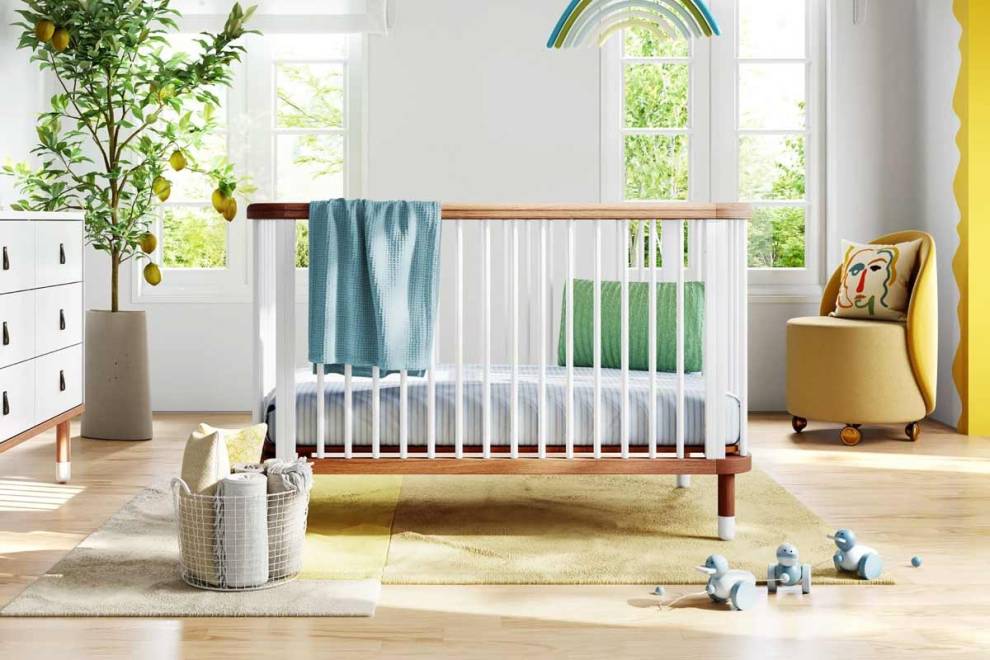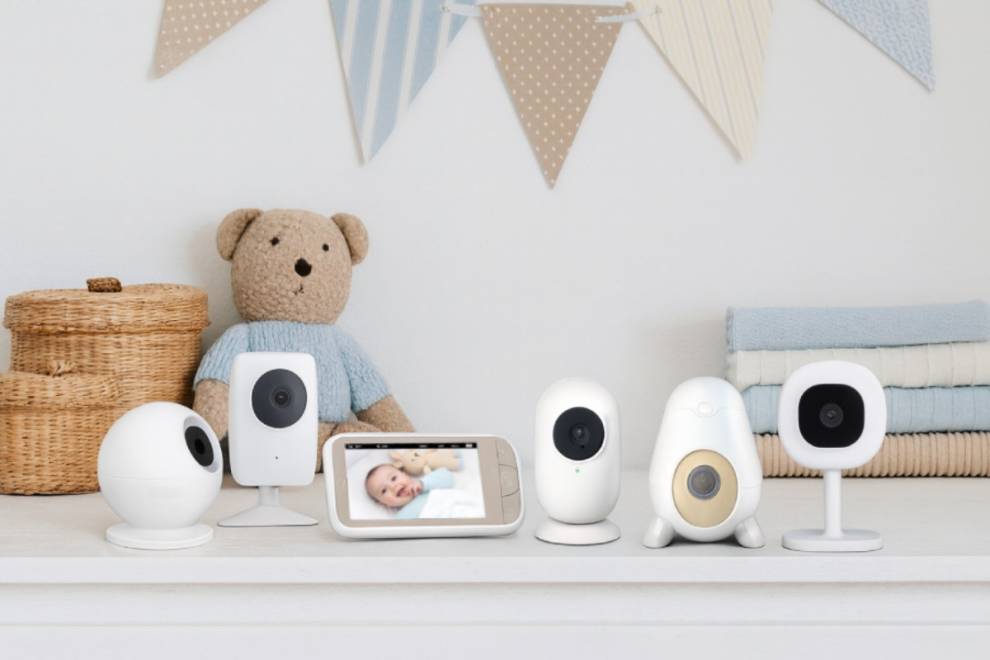Keep your little baby's soft skin well-hydrated with these soothing lotions.

Mommyhood101 independently tests and curates baby gear to help you make informed decisions. If you buy products through links on our site, we may earn a commission.
As your baby's skin develops and learns to regulate oil production, it goes through periods of dryness that can only be remedied by an effective baby lotion.
We've been reviewing baby lotions for over 10 years, and if we made our own, here are some of the key features it would have:
✔️ Hypoallergenic formulation.
✔️ Organic ingredients.
✔️ No fragrances or colors.
✔️ No sodium lauryl sulfate.
✔️ No sodium laureth sulfate.
✔️ No petroleum derivatives.
✔️ No mineral oil or lanolin.
✔️ Easy to apply.
✔️ Non-greasy application.
✔️ Dermatologist tested.
✔️ No animal testing.
✔️ Easy to apply.
✔️ Does not stain clothing.
✔️ Soothes for 12 hours.
✔️ Pump or easy dispenser.
Of course, you will also want the moisturizer to fit your fragrance preferences and meet your budget constraints. That's a lot to ask, and very few baby moisturizers meet the needs of picky parents!
-
- Top 5 Baby Lotions Comparison Table
- In-Depth Reviews
- 1. Best Overall: Honest Co. Balm
- 2. Earth Mama
- 3. California Baby
- 4. Aquaphor Baby
- 5. Aveeno Lotion
- 6. Noodle & Boo
- 7. Eucerin Baby
- 8. Babyganics Lotion
- 9. CeraVe Baby
- 10. Burt's Bees Baby Bee
- How to Pick a Great Baby Lotion
- Parabens in Moisturizers
- Phthalates in Moisturizers
- Sodium Lauryl Sulfate in Moisturizers
- Fragrances in Moisturizers
- Other Baby Lotions Not on This List
- Baby Dove Rich Moisture Lotion
- Johnson's Head-to-Toe Lotion
- Cetaphil Baby Daily Lotion
- Conclusions
Full disclosure: Some of these baby lotions, including the Honest Company, Noodle & Boo, and Burts Bees lotions, were sent to us as free test samples by the manufacturer.
To find the perfect baby lotion for your little one, we have revised over 25 different options.
Our reviews focus on odor, texture, effectiveness, and ingredient safety.
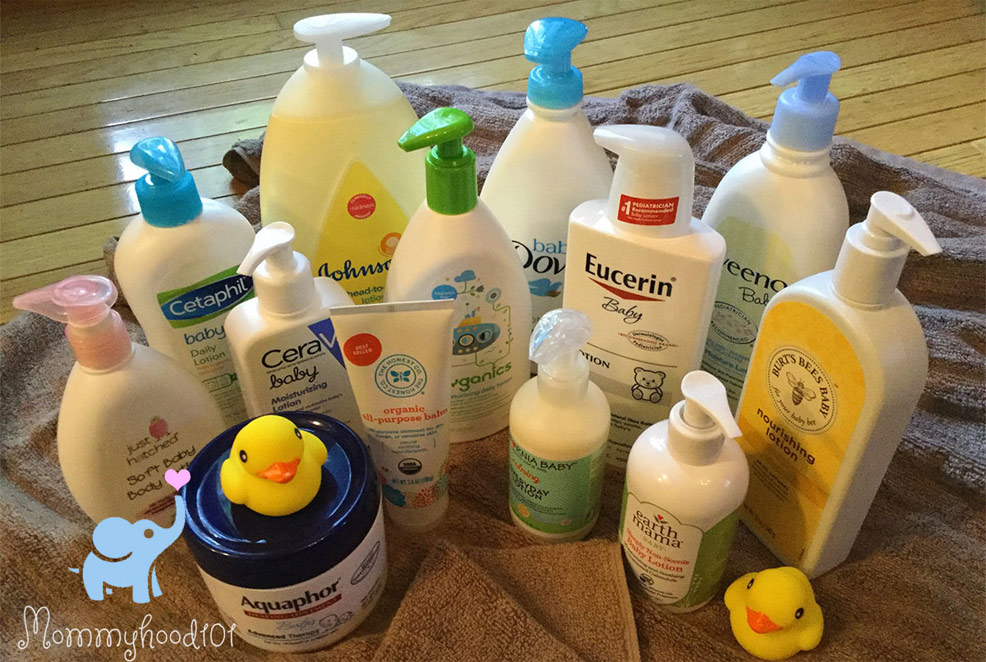
Here are the top 5 baby lotions we've tested, followed by in-depth reviews of several options.
The Top 5 Best Baby Lotions of 2026
| ★★★★★★★★★★ (10/10) | Our top-rated baby lotion for hydration and safety. Free from petroleum, mineral oils, and lanolin, with USDA organic ingredients that soothe dry or eczema-prone skin. Thick balm texture absorbs quickly without greasy residue — perfect for everyday moisture and healing. | CHECK PRICES | READ FULL REVIEW | |
| ★★★★★★★★★★ (10/10) | Certified organic, fragrance-free, and ultra-gentle. Absorbs fast with a clean, non-greasy finish. Great for babies with sensitive skin or fragrance allergies. Parents love the smooth texture and simple ingredients that meet the NSF/ANSI 305 organic standard. | CHECK PRICES | READ FULL REVIEW | |
| ★★★★★★★★★☆ (9/10) | Light, vegan-friendly lotion with a relaxing clary sage scent and organic ingredients. Absorbs quickly to leave skin soft and smooth. Excellent for dry or sensitive skin, though slightly pricey. A soothing daily lotion trusted by parents for over a decade. | CHECK PRICES | READ FULL REVIEW | |
| ★★★★★★★★☆☆ (8/10) | Dermatologist-recommended ointment for dry or eczema-prone skin. Provides long-lasting protection with 41% petroleum and skin-soothing moisturizers. Ideal for cracked or irritated skin, though slightly greasy. Affordable, reliable, and pediatrician-approved. | CHECK PRICES | READ FULL REVIEW | |
| ★★★★★★★★☆☆ (8/10) | Gentle, fragrance-free daily lotion featuring colloidal oatmeal for soothing hydration. Absorbs well without residue and helps protect delicate skin. An affordable, dermatologist-tested favorite that delivers comfort for mild dryness and eczema care. | CHECK PRICES | READ FULL REVIEW |
After nine cozy months suspended in warm amniotic fluid, your baby’s skin is sweet and perfectly soft. Once the umbilical cord and belly button heal and you start giving your baby full baths, you might notice them developing dry and sensitive skin. A good moisturizing lotion will help keep your little one's skin hydrated.
Including a soothing lotion as an after-bath routine creates wonderful bonding time with the baby, and you can throw in a little baby massage as an added bonus!
Before you pick a baby lotion, you want to make sure it's sensitive and safe for your baby's skin. We used the EWG Skin Deep Database to check the Hazard Score for each ingredient; this database rates both products and individual ingredients for safety on a scale of 1 to 10 (1 being the safest and 10 being the most potentially hazardous).
In-Depth Reviews of the Best Baby Lotions
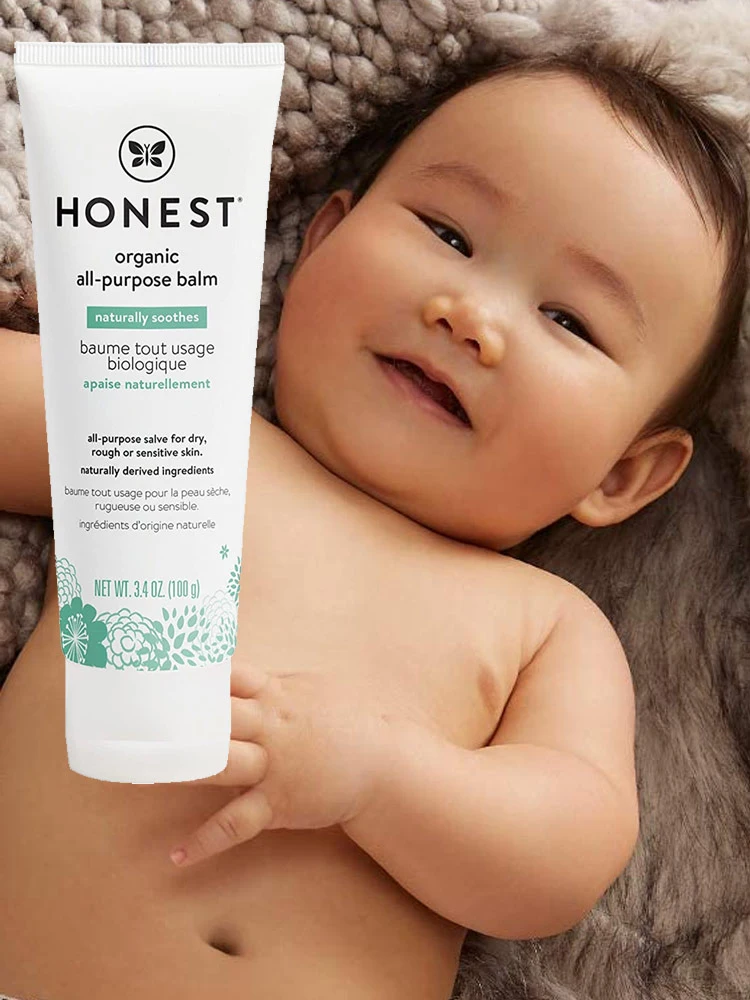
1. The Honest Company Organic All-Purpose Balm.
This Honest Company lotion has the consistency of a thick balm or salve but without a greasy residue. This is partly because the Honest balm uses no petroleum, mineral oils, or lanolin elements, so there are minimal stickiness, residue, allergen, or toxicity concerns. Additionally, almost all of the ingredients are USDA organic. Parents noticed the healing effects of this balm were excellent when used as a diapering ointment in place of petroleum. The All-Purpose Balm is absorbed quickly rather than just sitting on top of your baby’s skin. Some other parents noticed this product was highly effective at healing dry, scaly skin and eczema, and even seemed to help reduce some itching. In terms of ingredients and effectiveness, this was one of our absolute favorites.
While the Honest Company Baby Balm isn't included in the EWG database, we researched its ingredients: they are all rated 1 for minimal or no toxicity, which is very reassuring. The downside, however, is that it is also the most expensive product on this list. One 3.4-ounce tube of All-Purpose Balm is just over $12, making this product almost $3.58 per ounce! Because the balm is so thick, it is not easy to squeeze out all of the product, meaning some of this expensive balm may go to waste. One pro tip is to cut open the tube when it is “empty” and scoop the remaining product into a travel case to avoid wasting any of this precious baby balm. Who else loves the Honest Company Baby Balm? Our friends at Babylist and The Bump consider it a top pick! Interested? You can check out the Honest Company Balm here.

2. Earth Mama Simply Non-Scents Baby Lotion.
Earth Mama Non-Scents Lotion was the very first organic lotion certified to the NSF/ANSI 305 Standard for personal care products: there is no petroleum, mineral oil, parabens, or artificial fragrance. Due to its carefully selected and high-quality ingredients, it is no surprise that this is one of the more expensive products on this list. This lotion sells for almost $15 for one 8-ounce pump bottle, making it nearly $2 per ounce. We loved the easy-to-use, locking pump bottle. Non-Scents is a great name for this lotion - during our testing, we were surprised at just how unscented this product actually is. This is an important feature for some parents and children who are easily overwhelmed by powerful scents, and since babies also tend to have sensitive skin, we thought scent-free was a good choice for a baby lotion. This lotion is very thin and goes on smoothly. The minimal greasy feeling is absorbed within about five minutes, and the skin is left feeling soft and clean. When our baby was getting mild rashes during longer summer road trips in her convertible car seat, we used some of this on her arms and legs and it worked like a charm. Babies with very dry skin or eczema will likely need something a little more protective such as Aquaphor or Aveeno (below).
Overall, this is a great product for maintaining healthy, soft skin, and it feels great to apply and smells like, you guessed it, nothing! For ingredients, the EWG Skin Deep database rates this product as Level 1, for minimal or no hazard. There is some slight concern for the Organic Aloe Leaf Juice, which can have adverse effects if consumed. Additionally, Glyceryl Oleate can cause irritation of the skin, eyes, or lungs, so a test patch is advisable when first using this product (if your baby has super sensitive skin). Note that there are also a few ingredients in Non-Scents lotion that are non-biodegradable and/or potentially hazardous to the environment, including cetyl alcohol and glyceryl monostearate. Outside of that, we think this is an excellent fragrance-free baby lotion that works very well to soothe mild to moderately dry skin. Who else loves the Earth Mama baby lotion? Our friends at Babylist, Babygearlab, and WhatToExpect all consider it a top pick! Interested? You can check out this best baby lotion, Earth Mama Baby Lotion here.

3. California Baby Calming Everyday Lotion.
Immediately, every test parent in our focus group noticed this lotion’s scent - the clary sage aroma is quite strong, and our reviewers had mixed reactions. Some loved it, some hated it! It seems there is no middle ground when it comes to sage, and (like cilantro) we think it smells great. One of the more expensive products on this list, California Baby costs $16.68 for a locking, 6.5-ounce pump bottle, making this lotion over $2.50 per ounce. Some parents claim to have found it for less in certain large stores. The lotion is thin and absorbs quickly, leaving hands feeling smooth and without any greasy residue. We thought it did a fantastic job with sensitive and dry skin, and we would use it on a daily basis if it weren't for the price.
For ingredients, this lotion has an EWG score of 1, meaning minimal or no hazard. Many of the ingredients in California Baby Calming Lotion are certified organic. Additionally, there are numerous elements that have been sourced from coconut in this vegan-friendly lotion, including the cetyl alcohol, which otherwise draws ethical concerns when it is derived from animals. Similar to the Earth Mama Natural Non-Scents lotion (above), there is minimal cause for alarm regarding the inclusion of aloe leaf juice and potential harm from consumption. The overall EWG Skin Deep score reflects this with a low toxicity concern. Note that there are a few ingredients in California Baby lotion that are non-biodegradable and/or potentially hazardous to the environment, including ceteryl alcohol, cetyl alcohol, glyceryl monostearate, and caprylic/ capric triglyceride. Overall, if you don't mind the smell of sage, you will love this lotion and likely find it great for babies with very sensitive, dry skin. Who else loves the California baby lotion? Our friends at The Bump consider it a top pick! Interested? You can check out the California Baby Lotion here.
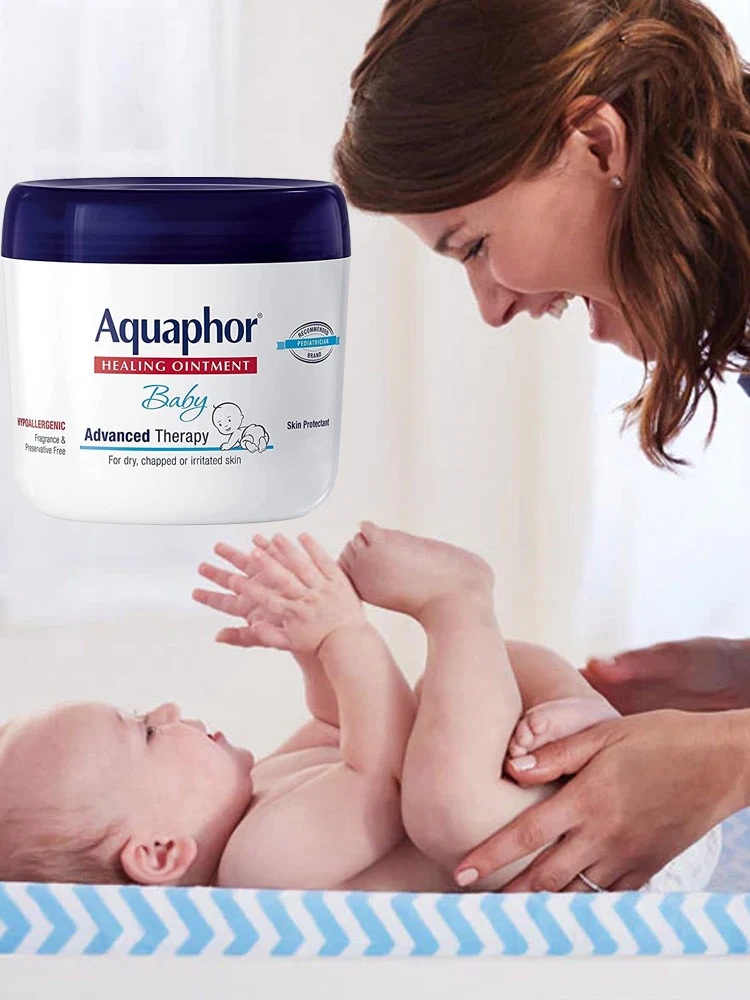
4. Aquaphor Healing Ointment Baby Advanced Therapy.
While the Petrolatum contamination risk was concerning, we are impressed by the long-standing quality testing of Aquaphor’s familiar brand. Additionally, a 2017 ProVoice survey rated Aquaphor Healing Ointment as the #1 dermatologist-recommended brand for dry, cracked skin and minor wound care. One 14-ounce jar is sold for just over $13, making this product affordable at under $1 per ounce, and the wide-mouth jar makes it easy to use every last drop. The petroleum in this product is 41%, with additional elements like oils and moisturizers, so unlike popular 100% petroleum salves, Aquaphor Healing Ointment Baby is more easily absorbed into the skin while creating a thin barrier for protection. This ointment was pediatrician-recommended to one of our test moms for her two-year-old son who had severe eczema. She had been unable to use perfumed lotions or creams because he would break out in a terrible rash. The Aquaphor Healing Ointment Baby was the only solution to heal his skin without causing more irritation.
Overall, we like the low EWG hazard score of 2, however, there are a few outliers on the ingredients list. Specifically, Glycerin (EWG Score 2), which can have a laxative effect if consumed in high volume, Lanolin Alcohol (EWG Score 3), which is derived from sheep oil glands and/or wool, and listed as a moderate concern for allergic reactions, and Petrolatum (EWG Score 4), which is also known as petroleum jelly, and is the only active ingredient in this Aquaphor Ointment. Petroleum also ranks as the highest potential hazard in terms of organ system toxicity (non-reproductive) and PAHs contamination concerns. This is a common ingredient in many cosmetics and skin care products and has no known health concerns when properly and fully refined. “However, petrolatum is often not fully refined in the US, which means it can be contaminated with toxic chemicals called polycyclic aromatic hydrocarbons (PAHs).” PAHs are associated with carcinogenic hazards. Overall, we think this Aquaphor healing ointment is great for babies with moderate to severely dry skin. It does leave a somewhat greasy layer on the skin, which is likely key to its protective properties. Who else recommends Aquaphor healing ointment? Our friends at Babylist, WhatToExpect, and The Bump also consider it a top pick! Interested? You can check out the Aquaphor Healing Ointment here.
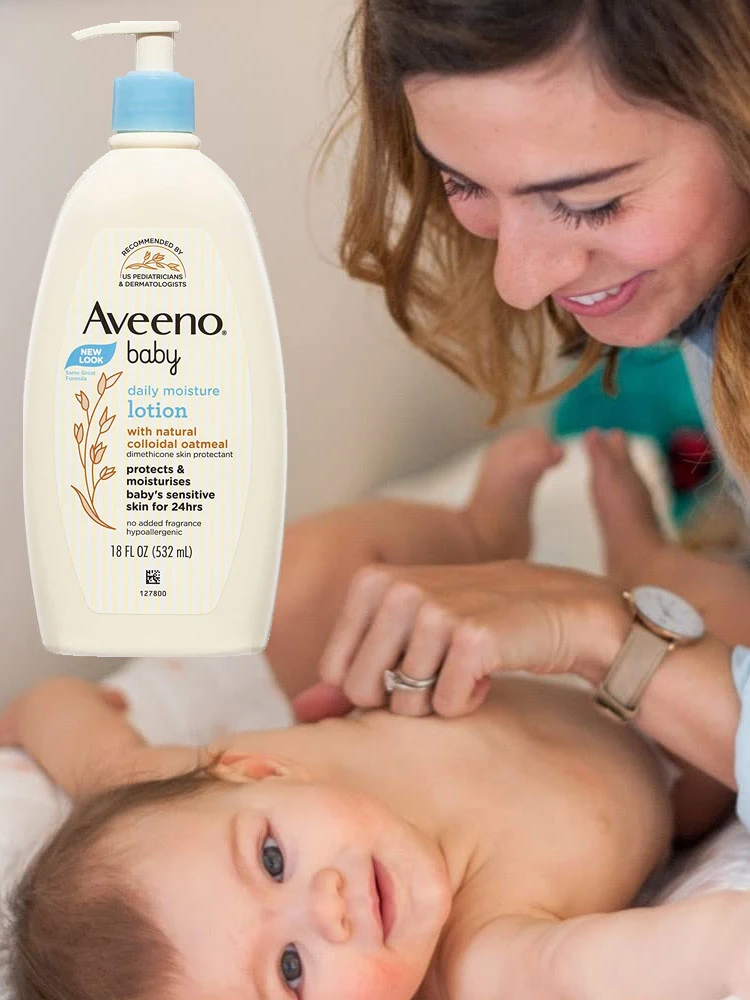
5. Aveeno Baby Daily Moisture Lotion.
For parents who were already familiar with Aveeno lotions, Aveeno Baby was notably thinner in texture and absorbed better than their typical adult lotions, leaving minimal residue on the skin. Highly affordable, one 18-ounce pump bottle ranges in price from $9 to $12, making this lotion less than 70 cents per ounce. This Aveeno Baby lotion is fragrance-free, but some of our testers found it to have a somewhat “soapy” smell. It includes colloidal oatmeal, which can naturally bind to the skin and create a highly protective barrier that prevents irritants from contacting the skin and helps support the skin with additional nutrients. Oatmeal also offers natural inflammation reduction. One of our testers used this on her toddler who suffered from allergic eczema, and she found it was both soothing and healing for his skin.
For ingredients, about half of the ingredients in the Aveeno Baby lotion score a 1 (low or no hazard) in the EWG database. The rest, however, range from 2 to 5 in score. These include Glycerin (EWG Score 2 for use restrictions and caution against consumption), Dimethicone (EWG Score 3, used as a skin conditioning agent in many cosmetics, this agent can result in non-reproductive organ system toxicity), Distearyldimonium Chloride (EWG Score 3, in addition to non-reproductive organ system toxicity, this element can be irritating to skin, eyes, or lungs, and there is strong evidence for potential allergic reaction in sensitive individuals), Petroleum (EWG Score 4, as seen in the Aquaphor Lotion, petroleum ranks for non-reproductive organ system toxicity and regulatory concerns regarding PAHs contamination), and Benzyl Alcohol (EWG Score 5 for use as a carrier/solvent, a preservative, and to make other chemicals. Contact with this chemical may irritate skin, eyes, and mucous membranes, and it may be toxic if consumed). There are also a few ingredients in Aveeno Baby lotion that are non-biodegradable and/or potentially hazardous to the environment, including ceteryl alcohol, dimethicone, and distearyldimonium chloride. So while it's not the best baby lotion on our list, it's definitely worth checking out. Also a top pick by our friends at Babylist, Babygearlab, and The Bump, you can check out the Aveeno Baby Lotion here.
6. Noodle & Boo Super Soft Baby Lotion.
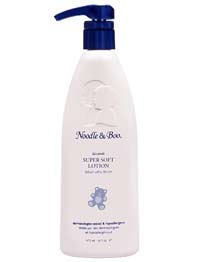
Noodle & Boo is one of our favorite baby care companies, with very high-quality and effective products including lotions, laundry detergents, and baby body washes. As a luxury brand, they are also somewhat expensive and come in relatively small sizes. For example, this Super Soft Lotion comes in a 16-ounce pump bottle for just under $20, making it about $1.15 per ounce. But once you try it, you might realize that it's worth every penny! Noodle & Boo products are made in the USA in a socially responsible manner, and their products are not tested on animals. This lotion is no exception, and it's also made from plant-based and hypoallergenic ingredients that are free of soy and gluten. It includes glycerin and almond oil and provides a protective layer of antioxidants that help protect your little one's skin from environmental elements. In our testing, we found it to be super silky smooth and had only a slight odor of almond oil and lavender. It did a great job going smoothly onto the skin and rubbing in (without any greasy or shiny residue) within about 30 seconds. Overall, we think this is a great new addition to our list, and if you can get your hands on the fragrance-free version it's even better! Interested? You can check out this Noodle & Boo baby lotion here.
Ingredients and EWG Hazard Rating for the Noodle and Boo lotion: Water, isopropyl palmitate (1), cetyl alcohol (1), stearyl alcohol (1), glycerin (2), glyceryl stearate (1), tocopherol (1), prunus amygdalus dulcis (sweet almond) oil (1), hydrolyzed casein (1), phenoxyethanol (4), sodium cocoyl isethionate (1), disodium edta (1), ethylhexylglycerin (2), ascorbic acid (1), ascorbyl palmitate (1), sodium dehydroacetate (1), citric acid (2), peg-8 (3), fragrance (1).
This specific Noodle & Boo Super Soft lotion, with the lavender fragrance, hasn't been rated by the EWG. The fragrance-free version, however, has been, and it received a really great score of 2. The fragrance ingredient found in this version, however, receives a pretty poor score of 8. If the EWG were to review it, that ingredient would likely bring this lotion up to a score of 4. Given how amazing this lotion is otherwise, we suggest getting the fragrance-free version and not needing to worry about potential allergies or immunotoxicity!
7. Eucerin Baby Body Lotion.
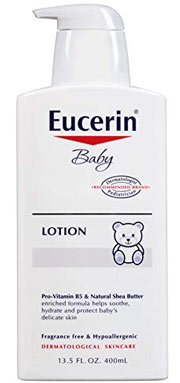
In our testing, we found the Eucerin Baby Lotion to be the wateriest lotion on this list. It comes in a lockable 13.5-ounce bottle, making this product very affordable at $0.66 per ounce. The spout must be fully compressed to activate the lock. We preferred the simpler twist-lock bottles such as Earth Mama and Aveeno as these made it easier to avoid wasting product simply because you want to lock the pump. Additionally, we noted that one full pump produced a lot of product - so, while this lotion might be good for a full-body baby massage, a full pump would be too much for just hands or feet. Eucerin Baby is fragrance-free and did not have the “soapy” smell some testers noticed with Aveeno. Many parents observed strong healing qualities with this lotion, helping to soothe skin irritation, rashes, and eczema. A couple of testers with very dry skin (not eczema) noted a warm tingling, which we attributed to the citric acid. Your baby might not find that sensation very comforting. Who else recommends the Eucerin baby lotion? Our friends at Babylist, Babygearlab, and WhatToExpect also call it a top pick!
Ingredients and EWG Hazard Rating for the Eucerin Baby Lotion: Water, Cetyl Palmitate, Glycerin, Mineral Oil, Cetyl Alcohol, Polybutene, Sorbitan Stearate, Tapioca Starch, Panthenol, Butyrospermum Parkii (Shea) Butter, Dimethicone, Phenoxethanol, Carbomer, Pentylene Glycol, Caprylyl Glycol, Sodium Hydroxide, Sodium Citrate, Citric Acid. This lotion has an EWG Skin Deep Score of 2. The majority of ingredients in Eucerin Baby lotion rank 1 on the EWG database for little toxicity concern.
Of the 18 ingredients listed, only five have a score of two or above. Cetyl alcohol, while low in hazard score, can carry health and ethical issues depending on whether it is sourced from animals. Eucerin Baby does not specify the source of cetyl alcohol in its product. There are 5 ingredients that range in score from 2 to 4. These include Citric Acid (EWG Score 2, which can be irritating and used as a skin-peeling agent), Glycerin (EWG Score 2, which has use restrictions to avoid consumption and has a possible laxative effect), Dimethicone (EWG Score 3, moderate hazard or potential non-reproductive organ system toxicity), Phenoxethanol (EWG Score 4, due to possible organ system toxicity, and should not be used around the mouth or lips due to toxicity and potential harm), and Sodium Hydroxide (EWG Score 4 due to highly caustic and reactive nature, moderate concern due to non-reproductive organ toxicity and possible irritation to the skin, eyes, or lungs). There are also a few ingredients in Eucerin Baby that are non-biodegradable and/ or potentially hazardous to the environment, including sorbitan stearate, cetyl alcohol, and dimethicone.
8. Babyganics Moisturizing Daily Lotion.
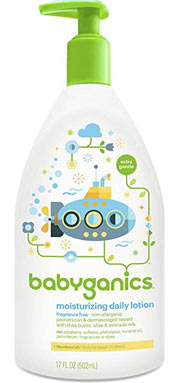
This was one of the thicker, more viscous lotions we tested, with the only exception being the balms or salves. Babyganics comes in a generous 17-ounce, twist-lock pump bottle for $7.50, making this the least expensive option. A single pump releases just enough to coat the baby's arms and legs with quickly-absorbing moisture. This rich, creamy lotion feels surprisingly light on the skin and leaves no greasy residue. Babyganics is fragrance-free, but like the Aveeno, we found it has a slight “soapy” scent - definitely not unpleasant, but noticeable. As we always say with this brand - it's a bit of a misleading company name (Babyganics) because most of their products are far from being organic. In fact, this one has an EWG Skin Deep Score of 3 due to some questionable ingredients. Who else recommends the Babyganics lotion? Our friends at Babygearlab and The Bump consider it a top pick! Interested? You can check out the Babyganics baby lotion here.
Ingredients and EWG Hazard Rating for the Babyganics Daily Lotion: Water, theobroma cacao (cocoa) seed butter, cetyl alcohol, squalene, decyl oleate, butyrospermum parkii (shea) butter, propanediol, glycerin, persea gratissima (avocado) oil, olea europaea (olive) fruit oil, canola oil, tocopheryl acetate, aloe barbadensis leaf juice, solanum lycopersicum (tomato) seed oil, helianthus annuus (sunflower) seed oil, vaccinium macrocarpon (cranberry) seed oil, nigella sativa (black cumin) seed oil, rubus idaeus (raspberry) seed oil, cetearyl alcohol, ceteareth-20, stearic acid, beeswax, carbomer, sodium hydroxide, caprylyl glycol, trisodium ethylenediamine disuccunate, sorbic acid, polynoxyethanol.
This product has an EWG Skin Deep Score of 3. A large majority of this lotion’s numerous ingredients are ranked 1 for minimal toxicity concern by the EWG database. Additionally, many of the ingredients are certified organic. Some of these low-hazard additives may cause irritation to skin, eyes, and lungs, including tocopherol and propanediol. Cetyl alcohol, while low in hazard score, can carry health and ethical issues depending on whether it is sourced from animals. Babyganics does not specify the source of cetyl alcohol in its product. The most concerning ingredients are similar to those contained in most of the other lotions: Glycerin (EWG Score 2), Ceteareth-20 (EWG Score 3), Sorbic Acid (EWG Score 3), Phenoxyethanol (EWG Score 4), and Sodium Hydroxide (EWG Score 4). There are also a few ingredients in Babyganics that are non-biodegradable and/ or potentially hazardous to the environment, including stearic acid, cetearyl alcohol, and cetyl alcohol.
9. CeraVe Baby Moisturizing Lotion.
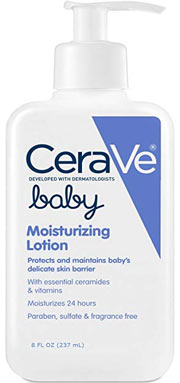
While we were concerned with the number of moderately hazardous scoring ingredients in this lotion, we were also impressed by the lack of fragrance, parabens, and sulfates. Additionally, the formula includes vitamins and ceramides backed by dermatologists and has earned The National Eczema Association Seal of Acceptance for safe use on eczema and sensitive skin. CeraVe Baby comes in a click-lock, 8-ounce bottle for $9, making this product just over $1 per ounce. Like Babyganics (above), this lotion is more viscous than many others on this list. It goes on smoothly with a minimal greasy feeling. It seems to work completely fine, but the ingredients list raises some safety concerns for babies. Recommended by our friends at Babylist, WhatToExpect, and The Bump, you can check out the CeraVe baby lotion here.
Ingredients and EWG Hazard Rating for the CeraVe baby lotion: Dimethicone, Purified Water, Caprylic/Capric Triglyceride, Cetostearyl Alcohol, Cetyl Alcohol, Emulsifying Wax, Niacinamide, Ceramide 3, Ceramide 6-II, Ceramide 1, Hyaluronic Acid, Allantoin, Tocopheryl Acetate, Lauric Acid, Zinc Citrate, Polygylceryl-3 Diisotearate, Behentrimonium methosulfate, Sodium Lauroyl Lactylate, Arginine PCA, Potassium Phosphate, Dipotassium Phosphate, EDTA, Sodium PCA, Phytosphingosine, Cholesterol, Xanthan Gum, Carbomer, Ethylhexylglycerin. This lotion has an EWG Skin Deep Score of 4. The vast majority of CeraVe Baby Lotion’s ingredients are rated 1 for minimal toxicity concern. Typically, safe sodium PCA is flagged for potential contamination in processing, and Cetyl alcohol, while low in hazard score, can carry health and ethical issues depending on whether it is sourced from animals. CeraVe does not specify the source of cetyl alcohol in its product. The most concerning ingredients in this are: EDTA, EWG Score 2: Used for enhanced skin absorption, this agent can cause non-reproductive organ toxicity as well as skin, eye, or lung irritation. Zinc Citrate, EWG Score 3: This salt agent from citric acid can cause non-reproductive organ toxicity, and its use in cosmetics is guarded by use restrictions differentiating concentration between leave-on and rinse-off products. Dimethicone, EWG Score 3: This ingredient is considered a moderate hazard or potential non-reproductive organ system toxicity. Tocopheryl Acetate, EWG Score 3: A skin conditioning chemical with strong evidence of skin toxicity and/or allergy in high doses. Behentrimonium methosulfate, EWG Score 4: Considered safe in restricted cosmetic use, this agent is known to cause toxic and/or allergic reactions for sensitive individuals. Emulsifying Wax, EWG Score 4: “Emulsifying wax is a mixture derived from plant- or petroleum-based wax converted into an emulsion with the aid of added [undefined] detergents.” This ingredient scores a moderate concern mostly for its lack of required labeling. There are also several ingredients in CeraVe that are non-biodegradable and/ or potentially hazardous to the environment, including cholesterol, cetyl alcohol, cetearyl alcohol, caprylic/capric triglyceride, zinc citrate, dimethicone, and tocopheryl acetate.
10. Burt's Bees Baby Bee Nourishing Lotion, Original.
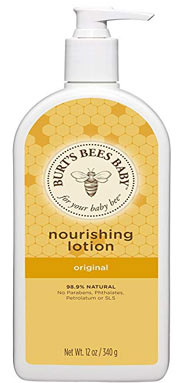
This lotion’s “natural fragrance” was pleasantly mild and both fruity and floral. The lotion was light and left only a mild residue, which evaporated quickly, leaving skin soft and without irritation. One press-and-twist-lock bottle sells for $8.50, making this product more affordable at just over $0.70 per ounce. We were pleased with this 99% natural, nourishing lotion, and while we were concerned with the “fragrance” element, we were put at ease by Burt’s Bees promise that the formula excluded parabens, phthalates, SLS, and petrolatum. Also recommended by our friends at Babygearlab and The Bump, you can check out the Burt's Bees baby lotion here.
Ingredients & EWG Hazard Rating for the Burt's Bees Nourishing Lotion: Aqua (water, eau), glycerin, decyl cocoate, helianthus annuus (sunflower) seed oil, cera alba (beeswax, cire d'abeille), butyrospermum parkii (shea) butter, polyglyceryl-3 stearate, glyceryl stearate citrate, cetyl alcohol, butyris lac (buttermilk powder, babeurre en poudre), cocos nucifera (coconut) oil, olea europaea (olive) fruit oil, vitis vinifera (grape) seed oil, aloe barbadensis leaf juice, chamomila recutita (matricaria) flower extract, calendula officinalis flower extract, centaurea cyanus flower extract, tilia cordata flower extract, rosmarinus officinalis (rosemary) leaf extract, anthemis nobilis flower extract, hypericum perforatum extract, parfum (natural fragrance), tocopherol, sucrose stearate, xanthan gum, glycine soja (soybean) oil, canola oil (huile de colza), lactic acid, citric acid, glucose, sodium chloride, sodium stearoyl lactylate, sodium benzoate, magnesium aluminum silicate, phenoxyethanol, glucose oxidase, lactoperoxidase, limonene. This Burt's Bees Nourishing Lotion has an EWG Skin Deep Score of 5, the highest score on this list. The majority of ingredients in this lotion are natural and thus score 1 for low or no toxic hazard. Just six ingredients score 2 or above. However, some of the mild scoring ingredients cause some alarm, including the use of tocopherol and magnesium aluminum silicate. Additionally, the use of an underdefined “fragrance” ingredient (which has an EWG Score of 8) raises a red flag, though Burt’s Bees clarifies that the fragrances used are “natural.” There are two additional ingredients that concern us: Phenoxethanol with its EWG Score of 4, and Lactic Acid with its EWG Score of 4. There are also a few ingredients in this Burt's Bees lotion that are non-biodegradable and/or potentially hazardous to the environment, including cetyl alcohol, sodium stearoyl lactylate, and fragrance.
How to Pick a Great Baby Lotion
In lotion selection, in addition to searching for products that have features you want, you should also be on the lookout for ingredients to avoid. Some of the major ingredient hazards include parabens, phthalates, sulfates, and fragrances or perfumes. You may wonder how these ingredients are allowed in cosmetic products if they are potentially toxic. But under the Federal Food, Drug, and Cosmetic Act (FD&C Act), cosmetic products and ingredients, other than color additives, do not need FDA approval before they go on the market. So, while products and chemical ingredients are under constant review, it takes time and legal processes to remove hazards from the general market.
- Parabens: Parabens are used as preservatives in cosmetics including lotions. Water-based lotions are more likely to require preservatives or other formula stabilizers. The concern with parabens is the potential for endocrine system impact. According to Nneka Leiba, a research analyst at EWG, “There’s more concern about the longer-chain parabens — butylparaben, isopropylparaben, isobutylparaben and propylparaben — which can mimic estrogen and disrupt normal hormone function. Methylparaben and ethylparaben are shorter-chain chemicals that appear to have fewer associated hazards.” So, while paraben-free is preferable, there are some lower-risk choices.
- Phthalates: According to the American Academy of Pediatrics, “Phthalates are man-made chemicals found in personal care and other products. Recent studies suggest that some phthalates can alter human male reproductive development.” As the study of phthalate toxicity has continued, many baby lotions have prioritized the removal of these chemicals.
- Sodium Lauryl Sulfate: This detergent/surfactant can actually work against moisturizing and healing by further aggravating dry skin and eczema.
- Fragrance / Perfume: As noted above, listing fragrance or perfume on a lotion bottle does not provide enough information for safety. Many fragrance formulas include phthalates and other harmful detergents, but they are not required to list them all. So, even if a lotion does not list phthalates in its ingredients, they may still be included in the “fragrance.” Further, “if a company uses an ingredient that is both a preservative and a fragrance, it can still claim the product to be "fragrance-free” if preservation is the ingredient’s primary purpose.” If you are not sure about an ingredient’s purpose, this is where the EWG Database comes in handy for research.
In addition to chemical additives, however, you should maintain awareness of natural elements that may cause harmful impacts to your baby’s skin. The unfortunate truth is that people have allergic reactions to natural elements every day, and “While most skin care and hair care is filled with potential allergy triggers, it turns out that organic versions are, to green parents’ dismay, among the worst offenders.” Dr. Maryann Mikhail, an attending dermatologist at Beth Israel Medical Center in New York explains that consuming natural allergens like peanut and tree nut oils can cause a life-threatening, anaphylaxis reaction. Contact allergy, on the other hand, while not necessarily life-threatening, can cause serious allergic impact including “horrible eczema.”
The prospect of finding a safe, naturally-focused baby lotion can be, at times, another dizzying challenge for parents. Overall, by focusing on avoiding specific, known toxicity hazards, and keeping allergic responses in mind, parents can narrow down some safe choices. Further, testing a new lotion is an important step to keeping your child’s skin healthy. One tip from our focus group is to test a small patch on your own inner arm before putting the lotion on your child. This area of skin tends to be more sensitive, and if you notice any unpleasant sensation or reaction, you might want to reconsider using the product on your baby—whose skin is much more delicate and susceptible than yours. If all goes well, proceed with a small test patch on your child (not on the face) before fully working the lotion into your baby’s skincare routine. And of course, you should always talk with your child’s pediatrician if you have any medical concerns.
Other Baby Lotion Options Not On This List
Baby Dove Rich Moisture Lotion included moderate- to high-level hazard ingredients such as petrolatum, dimethicone, triethanolamine, phenoxyethanol, and “fragrance.” The lotion was watery, and had a pleasant but moderately powerful scent, but the toxicity score was too high.
Johnson’s Head-to-Toe Lotion was a toss-up for us, because while we love the company’s history and continued formulations to make products safer, we couldn’t get past the ill-defined “fragrance” ingredient, especially because one of our focus group moms had a previous experience with this lotion reacting badly on her eczema-suffering toddler.
Cetaphil Baby Daily Lotion ranks level 5 on the EWG for moderate hazards, including specific ingredient concerns like “fragrance,” sodium hydroxide, propylene glycol, and other low hazards. However, one specific ingredient that stood out to us was prunus amygdalus dulcis (sweet almond) oil. Due to the potential for severe allergic reactions to nut oils (as discussed above), this product didn’t make the cut.
Conclusions
Babies have much thinner skin than adults, and thus, baby skin is much more sensitive and more prone to irritation. When you start looking for a baby lotion, odds are you want to protect your child’s skin from irritants and drying out—unfortunately, there are some lotions that will cause those reactions, so you need to know what you are looking for and what you should try to avoid. Many new parents will worry about proper skin care for their baby, and during the first one to two weeks (until the umbilical stump falls off), their baby will only need warm sponge baths to maintain clean, healthy skin. For this reason, newborn babies typically do not need lotion to soften or moisturize their skin, since they are not being submerged during bath time.
Check with your pediatrician if you notice your newborn has very dry patches on his skin; they may recommend localized application of olive oil or A‑D ointment. Once the belly button heals, you can begin bathing your baby in a baby bathtub or sink insert. The American Academy of Pediatrics recommends, “Three times a week during her first year may be enough. Bathing her more frequently may dry out her skin, particularly if soaps are used or moisture is allowed to evaporate from the skin.”
As demonstrated through our focus group testing, there are varying levels of viscosity. While we will broadly refer to all of these products as lotions, they can more appropriately be broken down into salves, creams, and lotions (with some overlap between the three). Salves (such as The Honest Company Balm and Aquaphor) are likely to be the best hydration so long as they do not create an impenetrable barrier on the skin (as possible with 100% petroleum products). These products typically have higher oil percentages, so they absorb slowly and enrich skin layers—which is what you are looking for in terms of lasting skin protection. The disadvantage, though, is the higher likelihood of petroleum in these products, which runs contamination risk with potentially carcinogenic PAHs chemicals.
Additionally, salves are more likely to leave a greasy residue that many find uncomfortable. In our testing, The Honest Company Balm was both petroleum-free and left no greasy feeling. Of course, none of the lotions reviewed here will keep your baby protected from mosquitoes or ticks, so be sure to also check out our reviews of the best mosquito repellants for kids!
Creams are thicker than lotions but thinner than salves, Babyganics and CeraVe were great examples of creams. These products are rich and smooth, but not as heavy as the salves. However, in order to maintain more effective hydration, creams (like salves) are likely to include petroleum or some other hydrating base. In CeraVe, we observed the under-defined emulsifying wax, which could pose a toxic or allergic response. Babyganics, however, used beeswax in its creamy formula.
Lotions are the wateriest products, as a matter of fact, they are likely to contain water as a main ingredient as observed in California Baby and Burt’s Bees Baby. While water is an innocuous ingredient, and while it might make us think of hydration, it is actually not the best ingredient for skin hydration because it evaporates so quickly. So, if you choose a water-based lotion, keep in mind you may need to apply it more frequently than a cream or a salve. Due to the evaporating water content in lotions, any greasy residue will probably fade soon after application.







